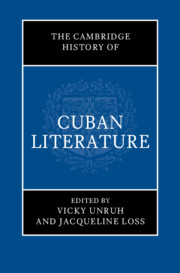Book contents
- The Cambridge History of Cuban Literature
- The Cambridge History of Cuban Literature
- Copyright page
- Dedication
- Contents
- Figures
- Contributors
- Acknowledgments
- Introduction Unfinished Histories
- Part I Literature in the Early Colony
- Part II Cuban Literature’s Long Nineteenth Century
- Part III Literary and Intellectual Culture in the Twentieth-Century Republic
- 13 The Literary Intellectuals of the Early Cuban Republic
- 14 The Invention of the Black Cuban in the Early Twentieth Century
- 15 The Fluid Expressive Communities of Cuba’s Interwar Avant-Gardes
- 16 Lydia Cabrera and Afro-Caribbean Imaginaries
- 17 The Fictions of New Urban Subjects
- 18 The Esthetics of Dulce María Loynaz
- 19 José Lezama Lima and the Orbits of Orígenes
- 20 Alejo Carpentier and Cuba’s Literary Twentieth Century
- 21 The Weighted Literary Islands of Virgilio Piñera
- Part IV The Revolution’s Literary-Cultural Initiatives and Their Early Discontents
- Part V Cuba and Its Diasporas into the New Millennium
- Epilogue
- Select Bibliography
- Index
- References
15 - The Fluid Expressive Communities of Cuba’s Interwar Avant-Gardes
from Part III - Literary and Intellectual Culture in the Twentieth-Century Republic
Published online by Cambridge University Press: aN Invalid Date NaN
- The Cambridge History of Cuban Literature
- The Cambridge History of Cuban Literature
- Copyright page
- Dedication
- Contents
- Figures
- Contributors
- Acknowledgments
- Introduction Unfinished Histories
- Part I Literature in the Early Colony
- Part II Cuban Literature’s Long Nineteenth Century
- Part III Literary and Intellectual Culture in the Twentieth-Century Republic
- 13 The Literary Intellectuals of the Early Cuban Republic
- 14 The Invention of the Black Cuban in the Early Twentieth Century
- 15 The Fluid Expressive Communities of Cuba’s Interwar Avant-Gardes
- 16 Lydia Cabrera and Afro-Caribbean Imaginaries
- 17 The Fictions of New Urban Subjects
- 18 The Esthetics of Dulce María Loynaz
- 19 José Lezama Lima and the Orbits of Orígenes
- 20 Alejo Carpentier and Cuba’s Literary Twentieth Century
- 21 The Weighted Literary Islands of Virgilio Piñera
- Part IV The Revolution’s Literary-Cultural Initiatives and Their Early Discontents
- Part V Cuba and Its Diasporas into the New Millennium
- Epilogue
- Select Bibliography
- Index
- References
Summary
This chapter on Cuba’s avant-gardes of the 1920s and early 1930s focuses on writers associated with the Grupo Minorista and the Revista de Avance, examining their cultivation of porous intellectual communities and the attention they paid to everyday expressive forms in seeking to translate Cuban orality into writing. These writers, the chapter argues, sought new ways of characterizing Cuban experience and identity, engaging critically with their surroundings and positioning themselves as consequential cultural actors. The chapter portrays the Minoristas’ approach to the tertulia as an affective assemblage that thrives on difference and artful disagreement, welcomes international visitors, and, while being capacious enough to include women, clings to gender stereotypes. It also draws connections between the group’s tertulias and the international cosmopolitan interactions forged by the conversational qualities of the Revista de Avance, with a literary and linguistic “art of eavesdropping,” stylistic self-consciousness, interstitial participant-observer positions, and hierarchical views of culture projected by such Minorista writing as the crónicas and essays of Jorge Mañach.
Keywords
- Type
- Chapter
- Information
- The Cambridge History of Cuban Literature , pp. 246 - 262Publisher: Cambridge University PressPrint publication year: 2024



